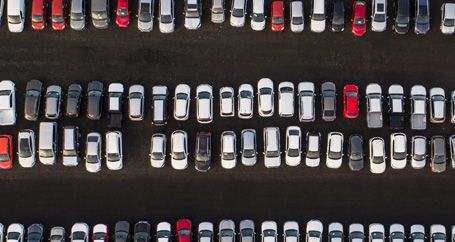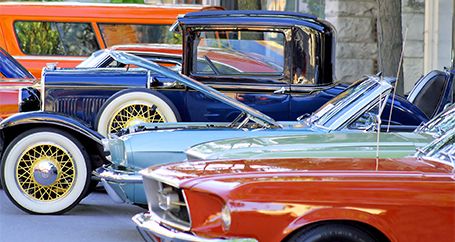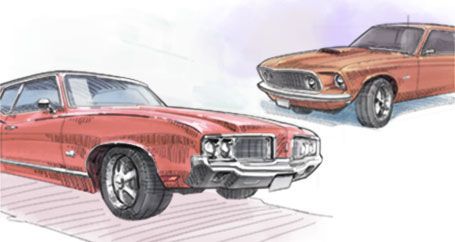"Your car can make a good first impression for very little investment."
— Josh Pfeiffer
For the past 22 years, Josh Pfeiffer has commanded an army of touch-up artists, ding fixers and seat stitchers. Their mission: recondition trade-ins for car dealers to the tune of about 1,000 vehicles a month. “We do the cosmetic repairs necessary to get these vehicles ready for sale,” he says. Here, Pfeiffer and Kelley Blue Book managing editor Matt DeLorenzo explain what generally pays off — and what doesn’t — when getting a car ready to trade in.
Dealers research the trade-in value — you should too.
The published trade-in value of a car is the starting point — the benchmark value whether you’re buying or selling the car, and that value fluctuates based on the condition of the car.
“Keep in mind that no two used cars are identical in terms of condition,” says DeLorenzo. “When we publish a trade-in value, it doesn’t dictate value in every instance. It’s a guide based on actual transaction data for a particular model, taking into account its condition, mileage and options.”
According to DeLorenzo, trade-in value declines by 5 to 10 percent at each step below Excellent.
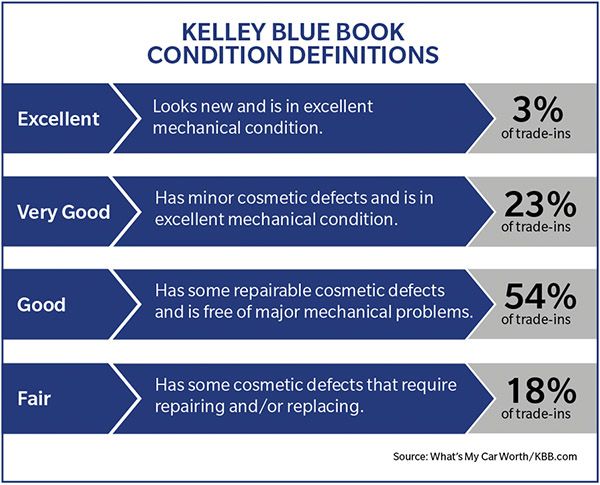
Dealers have a plan for selling your trade-in. You want them to sell it on their lot.
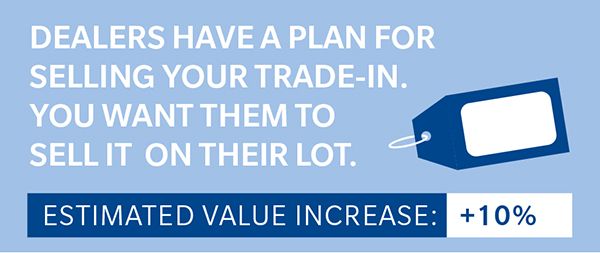
The rows of shiny used cars you see on a dealer’s lot generally represent the most marketable vehicles taken in trade. According to DeLorenzo, when dealers make an offer, it’s based partly on whether they intend to sell your car on their lot or send it to a wholesale auto auction.
Older cars and vehicles with excessive miles or known issues are likely to end up at auction, where they are sold to independent used-car lots at wholesale prices.
“If the used-car manager thinks the dealership can retail your car, you’re going to get about 10 percent more for it,” says Pfeiffer. “That’s a $2,000 difference on a $20,000 car.”
Late-model cars in good condition are prime candidates for retail, but some older ones make the cut too. “Some dealers I work with retail cars up to 20 years old if they’re in good shape,” Pfeiffer says. “Others don’t want anything more than five years old on their lot.”
"If your car’s mileage works out to more than 20,000 miles a year, it’s simply not a candidate for retail sale. "
— Josh Pfeiffer
DeLorenzo points to one telltale sign that your trade-in is headed for auction. “The clear majority of dealers don’t retail cars with excessive mileage. If your car’s mileage works out to more than 20,000 miles a year, it’s simply not a candidate for retail sale.”
Take it to the car wash. (Really, it helps)

Regardless of the published value of the car, you can expect the dealer to do a visual inspection before making an offer, says Pfeiffer. At a minimum, sellers should wash the exterior and vacuum the inside, he says. “The top cleaning package at your neighborhood drive-through car wash usually costs about $20 and includes a wax or polish. Your car can make a good first impression for very little investment.”
"Overall, a good do-it-yourself cleaning can make a Fair car look Good."
— Matt DeLorenzo
“Pay attention to the headlights,” DeLorenzo adds. “If they’re cloudy or yellowed, use a headlight restoration kit from a big-box retailer or auto supply shop for about $10 to clear up the lenses.” He doesn’t recommend replacing cloudy lenses. “That can cost a couple hundred [dollars] per light, and you’re never going to make that back on trade-in, let alone see a return.”
Pfeiffer also cautions against going all out and having your car professionally detailed, which he says costs up to $300 and may not have an impact on trade-in value. “Every trade-in that goes on the lot is going to be detailed by the dealer, usually through a contracted vendor. The cost is automatically factored into every trade-in offer.”
“Overall, a good do-it-yourself cleaning can make a Fair car look Good, and a Good car look Very Good,” says DeLorenzo. “That can increase what you get for your trade by 5 to 10 percent.”
In addition to the obligatory cleanup, DeLorenzo says to bring all service records with you. “It will show that you cared enough for the car to have it professionally maintained, which can only help your cause.”
Spend up to $300 on these fixes and let everything else go.

“You want to put your best car forward, but you can’t defy the market,” says DeLorenzo. Before spending a dime on repairs, check the trade-in value for the car in its current condition. Then, recalculate the value using the condition level above it. This is how much the value can increase if certain repairs are made.”
For example, if a 5-year-old family sedan in Fair condition has a listed trade-in value of $9,200. In Good condition, the same car is valued at $9,900. The seller stands to gain $700 (minus the cost of repairs) by bringing the car into Good condition.
"Because dealers can fix issues at wholesale cost, most repairs don’t come close to generating a return for the consumer."
— Josh Pfeiffer
But that doesn’t mean you can skip all repairs without leaving money on the table. “In my experience, there are certain things that make a really bad impression. These are the red flags that dealers look for — signs that the car has been neglected or abused.”

Windshield cracks
“Replacement is the only option for a cracked windshield,” says DeLorenzo. “Prices vary, so get a few estimates. Aim to spend no more than $300 on this or any one area of the car.”

Windshield cracks
“Replacement is the only option for a cracked windshield,” says DeLorenzo. “Prices vary, so get a few estimates. Aim to spend no more than $300 on this or any one area of the car.”
Chips or “stars” in the glass don’t require action, according to Pfeiffer. Based on his experience, he says these can cost $25 to $100 to repair, depending on the size, and fixing these flaws is part of the normal reconditioning process at many dealerships.

Upholstery damage
“If you have a single tear or burn in the seats, it’s worth getting fixed,” says Pfeiffer. “Look for a vendor who offers spot repairs — preferably for around $100. Repairing multiple spots or getting the seat reupholstered isn’t going to pay off.”

Upholstery damage
“If you have a single tear or burn in the seats, it’s worth getting fixed,” says Pfeiffer. “Look for a vendor who offers spot repairs — preferably for around $100. Repairing multiple spots or getting the seat reupholstered isn’t going to pay off.”

Older, worn tires
There are no extra points for having new rubber, but you will pay a penalty for heavily worn tires. When in doubt, DeLorenzo recommends this penny test: “Put a penny upside down in the tread. If you can still see the top of Lincoln’s head, you might need new tires.”

Older, worn tires
There are no extra points for having new rubber, but you will pay a penalty for heavily worn tires. When in doubt, DeLorenzo recommends this penny test: “Put a penny upside down in the tread. If you can still see the top of Lincoln’s head, you might need new tires.”
But consider DeLorenzo’s recommended $300 limit — the breakpoint where your effort and investment may not net a return. Think about the overall value of the car, as well, says Pfeiffer. “Check the fair market value of your car, meaning what the dealer can sell it for. If it’s under $10,000, you’re less likely to see a return from new tires.”

Warning lights
Unless your car is clearly bound for wholesale auction, the dealer will take it on a brief test drive. Warning lights indicate a problem in a general area — like engine cooling or electrical — but don’t say exactly what the issue is.

Warning lights
Unless your car is clearly bound for wholesale auction, the dealer will take it on a brief test drive. Warning lights indicate a problem in a general area — like engine cooling or electrical — but don’t say exactly what the issue is.
“The problem could be minor, like a faulty sensor or worn gas cap — or a major mechanical issue requiring costly repair,” says Pfeiffer. “To avoid losing money on the car, the dealer may assume the worst and value it accordingly. So definitely get the problem diagnosed and fixed if the cost doesn’t exceed $300.”

Tepid air conditioning
“This fix could cost very little or a ton to repair,” says Pfeiffer. “If the AC is blowing warm air, you should consider recharging it with refrigerant using a store-bought kit, which can cost about $40.” If a recharge solves the problem, you can add hundreds of dollars in value. If not, Pfeiffer says step away and let the dealer subtract what they will.

Tepid air conditioning
“This fix could cost very little or a ton to repair,” says Pfeiffer. “If the AC is blowing warm air, you should consider recharging it with refrigerant using a store-bought kit, which can cost about $40.” If a recharge solves the problem, you can add hundreds of dollars in value. If not, Pfeiffer says step away and let the dealer subtract what they will.

Scratches and dings
“When dealers make an offer, they take for granted that your car’s body might have small imperfections here and there,” says DeLorenzo. “But if you have a bunch of scrapes or dings, their confidence in the whole car declines. Any wear that’s beyond the level the dealer typically sees can have a disproportionate impact on the trade-in offer.”

Scratches and dings
“When dealers make an offer, they take for granted that your car’s body might have small imperfections here and there,” says DeLorenzo. “But if you have a bunch of scrapes or dings, their confidence in the whole car declines. Any wear that’s beyond the level the dealer typically sees can have a disproportionate impact on the trade-in offer.”
Your most cost-effective repair option, according to Pfeiffer, may be a mobile “scratch and dent” service, not a traditional body shop. “These companies will go over the exterior and do touch-ups and small dent removal where needed. Three hundred dollars’ worth of nips and tucks might not correct everything, but it may help change the dealer’s perception of your car.”
“No one jumps up and down over the trade-in offer they receive,” says Pfeiffer. “People always think their car is worth more — and they’re right. But remember that the dealer has to do inspections, reconditioning and marketing — or pay a commission to an auction facility — while hopefully eking out a profit. The alternative is trying to sell the car yourself, and who really wants to do that? The difference between what you get for your car at trade-in and what it’s really worth is the fee you pay the dealer for selling your car for you. For most of us, that’s money well spent.”
Written by
The information contained in this page is provided for general informational purposes only. The information is provided by Farmers® and while we endeavor to keep the information up to date and correct, we make no representations or warranties of any kind, express or implied, about the completeness, accuracy, reliability, suitability or availability with respect to this article or the information, products, services or related graphics, if any, contained in this article for any purpose. The information is not meant as professional or expert advice, and any reliance you place on such information is therefore strictly at your own risk.
Related articles
